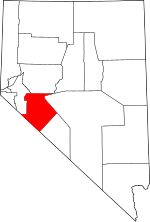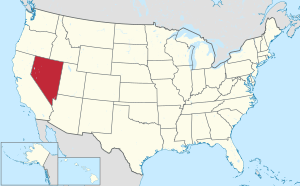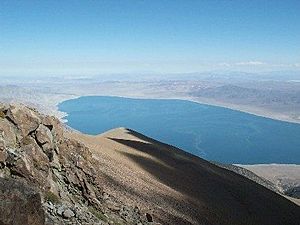Mineral County, Nevada facts for kids
Quick facts for kids
Mineral County
|
||
|---|---|---|

Historic 1883 Esmeralda County and Mineral County Courthouse.
|
||
|
||

Location within the U.S. state of Nevada
|
||
 Nevada's location within the U.S. |
||
| Country | ||
| State | ||
| Founded | 1911 | |
| Named for | Mineral | |
| Seat | Hawthorne | |
| Largest community | Hawthorne | |
| Area | ||
| • Total | 3,813 sq mi (9,880 km2) | |
| • Land | 3,753 sq mi (9,720 km2) | |
| • Water | 60 sq mi (200 km2) 1.6% | |
| Population
(2020)
|
||
| • Total | 4,554 | |
| • Density | 1.19434/sq mi (0.46114/km2) | |
| Time zone | UTC−8 (Pacific) | |
| • Summer (DST) | UTC−7 (PDT) | |
| Congressional district | 4th | |

Mineral County is a county located in the U.S. state of Nevada. As of the 2020 census, the population was 4,554, making it the fifth-least populous county in Nevada. Its county seat is Hawthorne.
Contents
History
Mineral County was carved out of Esmeralda County in 1911 shortly after the county seat of Esmeralda was moved to Goldfield in 1907. Its name came from the surrounding area, which is heavily mineralized. Hawthorne has always been its county seat. The county is listed as Nevada Historical Marker 16. The marker is located on U.S. Highway 95 at Walker Lake.
Geography
According to the U.S. Census Bureau, the county has a total area of 3,813 square miles (9,880 km2), of which 3,753 square miles (9,720 km2) is land and 60 square miles (160 km2) (1.6%) is water. The highest point in Mineral County is Mount Grant at 11,285 ft (3,440 m).
Major highways
 Interstate 11 (Future)
Interstate 11 (Future) U.S. Route 6
U.S. Route 6 U.S. Route 95
U.S. Route 95
 U.S. Route 95 Alternate
U.S. Route 95 Alternate
 U.S. Route 95 Truck (Hawthorne)
U.S. Route 95 Truck (Hawthorne) State Route 359
State Route 359 State Route 360
State Route 360 State Route 361
State Route 361
Adjacent counties
- Lyon County - northwest
- Churchill County - north
- Nye County - northeast
- Esmeralda County - southeast
- Mono County, California - southwest
National protected areas
- Inyo National Forest (part)
- Toiyabe National Forest (part)
Demographics
| Historical population | |||
|---|---|---|---|
| Census | Pop. | %± | |
| 1920 | 1,848 | — | |
| 1930 | 1,863 | 0.8% | |
| 1940 | 2,342 | 25.7% | |
| 1950 | 5,560 | 137.4% | |
| 1960 | 6,329 | 13.8% | |
| 1970 | 7,051 | 11.4% | |
| 1980 | 6,217 | −11.8% | |
| 1990 | 6,475 | 4.1% | |
| 2000 | 5,071 | −21.7% | |
| 2010 | 4,772 | −5.9% | |
| 2020 | 4,554 | −4.6% | |
| 2023 (est.) | 4,528 | −5.1% | |
| U.S. Decennial Census 1790-1960 1900-1990 1990-2000 2010-2018 |
|||
2010 census
At the 2010 census, there were 4,772 people, 2,240 households, and 1,258 families living in the county. The population density was 1.3 inhabitants per square mile (0.50/km2). There were 2,830 housing units at an average density of 0.8 per square mile (0.31/km2). The racial makeup of the county was 72.5% white, 15.5% Native American, 4.1% black or African American, 1.1% Asian, 0.1% Pacific islander, 2.1% from other races, and 4.4% from two or more races. Those of Hispanic or Latino origin made up 9.1% of the population. In terms of ancestry, 23.8% were English, 18.5% were German, 13.8% were Irish, 9.3% were Scottish, 5.2% were Portuguese, and 3.7% were American.
Of the 2,240 households, 21.2% had children under the age of 18 living with them, 39.0% were married couples living together, 11.2% had a female householder with no husband present, 43.8% were non-families, and 36.7% of households were made up of individuals. The average household size was 2.11 and the average family size was 2.70. The median age was 49.2 years.
The median household income was $35,446 and the median family income was $57,064. Males had a median income of $48,281 versus $33,830 for females. The per capita income for the county was $23,226. About 11.4% of families and 19.1% of the population were below the poverty line, including 11.0% of those under age 18 and 12.6% of those age 65 or over.
Communities
There are no incorporated communities in Mineral County.
Census-designated places
Unincorporated communities
Other places
See also
 In Spanish: Condado de Mineral (Nevada) para niños
In Spanish: Condado de Mineral (Nevada) para niños



